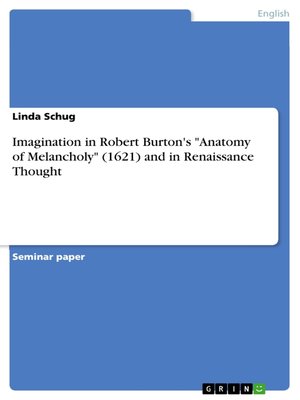Imagination in Robert Burton's "Anatomy of Melancholy" (1621) and in Renaissance Thought
ebook
By Linda Schug

Sign up to save your library
With an OverDrive account, you can save your favorite libraries for at-a-glance information about availability. Find out more about OverDrive accounts.
Find this title in Libby, the library reading app by OverDrive.



Search for a digital library with this title
Title found at these libraries:
| Library Name | Distance |
|---|---|
| Loading... |
Seminar paper from the year 2003 in the subject English Language and Literature Studies - Literature, grade: 2,7, University of Frankfurt (Main), course: Englische Prosa des 17. Jahrhunderts: Robert Burton und Sir Thomas Browne, language: English, abstract: The word 'imagination' has and had various meanings as this extract from The Oxford English Dictionary illustrates: 1. The action of imagining, or forming a mental concept of what is not actually present to the senses [...]; the result of this process, a mental image or idea (often with implication that the conception does not correspond to the reality of things, hence freq. vain (false, etc.) imagination [...] 2. The mental consideration of actions or events not yet in existence a. Scheming or devising; a device, contrivance, plan, scheme, plot, a fancyful project [...] b. Impression as to what is likely; expectation, anticipation. [...] These are the definitions that existed in the Renaissance period. But as I am going to show in my essay with the example of Robert Burton's The Anatomy of Melancholy (1621), imagination played a more influential role during that period and was believed to have and had a big impact on different spheres of life. Of course, there was no homogeneous opinion about its influence. As Katherine Park notes, the debate over the force of imagination 'was complicated by the fact that the most ardent defenders of the power of imagination included both the most credulous - writers like Paracelsus who would believe any story - as well as the least superstitious - writers like Pomponazzi and Montaigne for whom the imagination provided a credible and natural explanation for some of the more far-fetched claims of popular magic and religion.' (Huet 14) So I will point out to what extent Burton's ideas about it correspond to the views of his contemporaries and also how far they are more influenced by tradition. I am going to start with a passage about the contemporary development of the scientific method and an introduction to the circulating thoughts about imagination. Based on this, I will show how some trends of thinking are reflected and I will take a closer look at the contexts in which imagination or fancy appear in The Anatomy of Melancholy. Apart from the part entitled "Of the Force of Imagination", this mental power resonates in many other sections, too. It is connected to the medical sphere where it influences the unborn child and the health, as well as to dreams and to the supernatural - not just in the sense that demons and witches are the monstrous products of fantasy. They were also thought to have a strong influence on the imagination itself.







